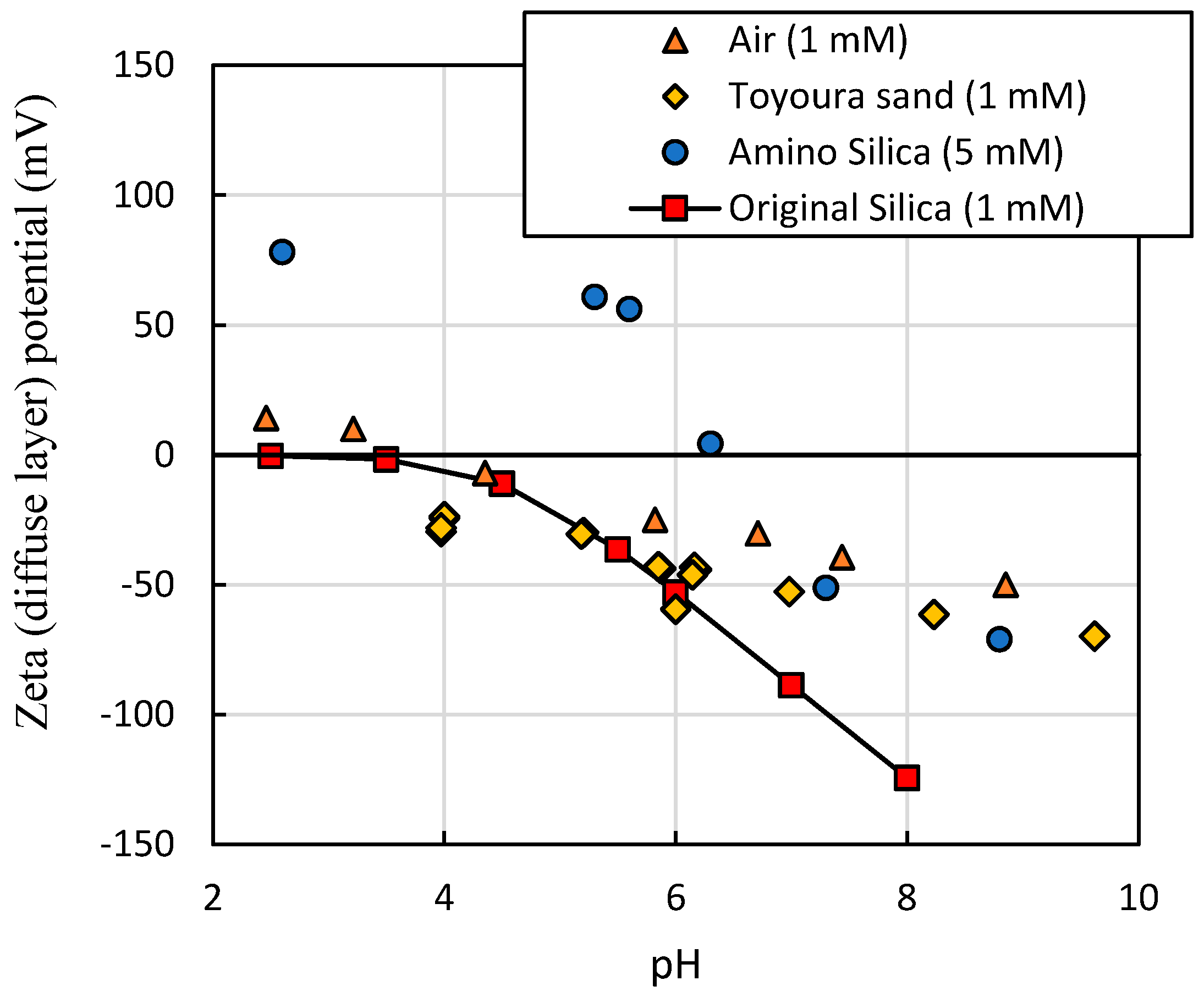The Initial Deposition Behavior of Silica Colloid and Amino-Modified Silica Colloid in Unsaturated Sand Columns
Abstract
1. Introduction
2. Materials and Methods
2.1. Colloidal Particles
2.2. Collector Particles Composing Porous Media
2.3. Experimental Procedure
2.4. Colloid Transport Model
3. Results and Discussion
3.1. Colloid Transport Experiment in the Column
3.2. Deposition Rate Constants
3.3. Comparison of the Experimental Value of Single Collector Efficiency with Calculated Value of by TE Equation in Water-Saturated Condition
4. Conclusions
Author Contributions
Funding
Conflicts of Interest
Abbreviations
| AWI | Air–water interface |
| AWS | Air–water–solid interface |
| CDC | Critical deposition concentration |
| EDL | Electric double layer |
| PV | Pore volume |
| C | Colloid concentration |
| C0 | Initial colloid concentration |
| t | Time |
| Dh | Dispersion coefficient |
| D | Diffusion coefficient |
| x | Distance from column inlet |
| v | Pore water velocity |
| U | Approach velocity |
| L | Column length |
| k | Boltzmann constant |
| g | Gravitational acceleration |
| θ | Volumetric water contents |
| kpc | Deposition rate constants |
| η0 | Single collector efficiency |
| α | Attachment efficiency |
| dc | Collector diameter |
| dp | Particle diameter |
| ρp | Particle density |
| ρf | Fluid density |
| µ | Fluid viscosity |
| T | Temperature |
| A | Hamaker constant |
| f | Porosity |
| As | Happel model parameter |
| ηD | Collector efficiency by diffusion |
| ηI | Collector efficiency by interception |
| ηG | Collector efficiency by sedimentation |
| NR | Aspect ratio |
| NPE | Peclet number characterizing ratio of convective transport to diffusive transport |
| Nvdw | van der Waals number characterizing ratio of van der Waals interaction energy to the particle’s thermal energy |
| NA | Represents combined influence of van der Waals attraction forces and fluid velocity on particle deposition rate due to interceptionGravity |
| NG | Ratio of Stokes particle settling velocity to approach velocity of the fluid |
| ω |
References
- Yao, K.M.; Habibian, M.T.; O’Melia, C.R. Water and waste water filtration. Concepts and applications. Environ. Sci. Technol. 1971, 5, 1105–1112. [Google Scholar] [CrossRef]
- Kretzschmar, R.; Borkovec, M.; Grolimund, D.; Elimelech, M. Mobile subsurface colloids and their role in contaminant transport. Adv. Agron. 1999, 66, 121–193. [Google Scholar] [CrossRef]
- McCarthy, J.; Zachara, J. ES & T Features: Subsurface transport of contaminants. Environ. Sci. Technol. 1989, 23, 496–502. [Google Scholar] [CrossRef]
- Novikov, A.P.; Kalmykov, S.N.; Utsunomiya, S.; Ewing, R.C.; Horreard, F.; Merkulov, A.; Clark, S.B.; Tkachev, V.V.; Myasoedov, B.F. Colloid transport of plutonium in the far-field of the Mayak Production Association. Russia. Sci. 2006, 314, 638–641. [Google Scholar] [CrossRef]
- Yamaguchi, N.; Mitome, M.; Akiyama-Hasegawa, K.; Asano, M.; Adachi, K.; Kogure, T. Internal structure of cesium-bearing radioactive microparticles released from Fukushima nuclear power plant. Sci. Rep. 2016, 6, 20548. [Google Scholar] [CrossRef]
- Saiers, J.E.; Lenhart, J.J. Ionic-strength effects on colloid transport and interfacial reactions in partially saturated porous media. Water Resour. Res. 2003, 39. [Google Scholar] [CrossRef]
- Torkzaban, S.; Bradford, S.A.; van Genuchten, M.T.; Walker, S.L. Colloid transport in unsaturated porous media: The role of water content and ionic strength on particle straining. J. Contam. Hydrol. 2008, 96, 113–127. [Google Scholar] [CrossRef]
- Fujita, Y.; Kobayashi, M. Transport of colloidal silica in unsaturated sand: Effect of charging properties of sand and silica particles. Chemosphere 2016, 154, 179–186. [Google Scholar] [CrossRef]
- Morales, V.L.; Sang, W.; Fuka, D.R.; Lion, L.W.; Gao, B.; Steenhuis, T.S. Impact of dissolved organic matter on colloid transport in the vadose zone: Deterministic approximation of transport deposition coefficients from polymeric coating characteristics. Water Res. 2011, 45, 1691–1701. [Google Scholar] [CrossRef]
- Zevi, Y.; Dathe, A.; Mccarthy, J.F.; Richards, B.K.; Steenhuis, T.S. Distribution of colloid particles onto interfaces in partially saturated sand. Environ. Sci. Technol. 2005, 39, 7055–7064. [Google Scholar] [CrossRef]
- Wang, Z.; Zhang, W.; Li, S.; Zhou, J.; Liu, D. Transport of silica colloid through saturated porous media under different hydrogeochemical and hydrodynamic conditions considering managed aquifer recharge. Water 2016, 8, 555. [Google Scholar] [CrossRef]
- Chen, Y.; Ma, J.; Wu, X.; Weng, L.; Li, Y. Sedimentation and Transport of Different Soil Colloids: Effects of Goethite and Humic Acid. Water 2020, 12, 980. [Google Scholar] [CrossRef]
- Guerrero-Martínez, A.; Pérez-Juste, J.; Liz-Marzán, L.M. Recent progress on silica coating of nanoparticles and related nanomaterials. Adv. Mater. 2010, 22, 1182–1195. [Google Scholar] [CrossRef]
- Tufenkji, N.; Elimelech, M. Correlation equation for predicting single-collector efficiency in physicochemical filtration in saturated porous media. Environ. Sci. Technol. 2004, 38, 529–536. [Google Scholar] [CrossRef]
- Nelson, K.E.; Ginn, T.R. New collector efficiency equation for colloid filtration in both natural and engineered flow conditions. Water Resour. Res. 2011, 47. [Google Scholar] [CrossRef]
- Elimelech, M.; O’Melia, C.R. Effect of particle size on collision efficiency in the deposition of Brownian particles with electrostatic energy barriers. Langmuir 1990, 6, 1153–1163. [Google Scholar] [CrossRef]
- Elimelech, M. Kinetics of capture of colloidal particles in packed beds under attractive double layer interactions. J. Colloid Interface Sci. 1991, 146, 337–352. [Google Scholar] [CrossRef]
- Wan, J.; Tokunaga, T.K. Partitioning of clay colloids at air–water interfaces. J. Colloid Interface Sci. 2002, 247, 54–61. [Google Scholar] [CrossRef]
- Lenhart, J.J.; Saiers, J.E. Transport of silica colloids through unsaturated porous media: Experimental results and model comparisons. Environ. Sci. Technol. 2002, 36, 769–777. [Google Scholar] [CrossRef]
- Crist, J.T.; McCarthy, J.F.; Zevi, Y.; Baveye, P.; Throop, J.A.; Steenhuis, T.S. Pore-scale visualization of colloid transport and retention in partly saturated porous media. Vadose Zone J. 2004, 3, 444–450. [Google Scholar] [CrossRef]
- Mitropoulou, P.N.; Syngouna, V.I.; Chrysikopoulos, C.V. Transport of colloids in unsaturated packed columns: Role of ionic strength and sand grain size. Chem. Eng. J. 2013, 232, 237–248. [Google Scholar] [CrossRef]
- Sang, W.; Morales, V.L.; Zhang, W.; Stoof, C.R.; Gao, B.; Schatz, A.L.; Zhang, Y.; Steenhuis, T.S. Quantification of colloid retention and release by straining and energy minima in variably saturated porous media. Environ. Sci. Technol. 2013, 47, 8256–8264. [Google Scholar] [CrossRef]
- Donaldson, S.H., Jr.; Røyne, A.; Kristiansen, K.; Rapp, M.V.; Das, S.; Gebbie, M.A.; Lee, D.W.; Stock, P.; Valtiner, M.; Israelachvili, J. Developing a general interaction potential for hydrophobic and hydrophilic interactions. Langmuir 2015, 31, 2051–2064. [Google Scholar] [CrossRef]
- Bradford, S.A.; Torkzaban, S. Colloid transport and retention in unsaturated porous media: A review of interface-, collector-, and pore-scale processes and models. Vadose Zone J. 2008, 7, 667–681. [Google Scholar] [CrossRef]
- Flury, M.; Surachet, A. Role of air-water interfaces in colloid transport in porous media: A review. Water Resour. Res. 2017, 53, 5247–5275. [Google Scholar] [CrossRef]
- Zhang, W.; Zhang, W.; Morales, V.L.; Cakmak, M.E.; Salvucci, A.E.; Geohring, L.D.; Hay, A.G.; Parlange, J.Y.; Steenhuis, T.S. Colloid transport and retention in unsaturated porous media: Effect of colloid input concentration. Environ. Sci. Technol. 2010, 44, 4965–4972. [Google Scholar] [CrossRef]
- Johnson, P.R.; Elimelech, M. Dynamics of colloid deposition in porous media: Blocking based on random sequential adsorption. Langmuir 1995, 11, 801–812. [Google Scholar] [CrossRef]
- Kuhnen, F.; Barmettlera, K.; Bhattacharjeeb, S.; Elimelechb, M.; Kretzschmara, R. Transport of iron oxide colloids in packed quartz sand media: Monolayer and multilayer deposition. J. Colloid Interface Sci. 2000, 231, 32–41. [Google Scholar] [CrossRef]
- Kobayashi, M.; Skarba, M.; Galletto, P.; Cakara, D.; Borkovec, M. Effects of heat treatment on the aggregation and charging of Stöber-type silica. J. Colloid Interface Sci. 2005, 292, 139–147. [Google Scholar] [CrossRef]
- Hiemstra, T.; Van Riemsdijk, W.H.; Bolt, G.H. Multisite proton adsorption modeling at the solid/solution interface of (hydr) oxides: A new approach: I. Model description and evaluation of intrinsic reaction constants. J. Colloid Interface Sci. 1989, 133, 91–104. [Google Scholar] [CrossRef]
- Kobayashi, M.; Juillerat, F.; Galletto, P.; Bowen, P.; Borkovec, M. Aggregation and charging of colloidal silica particles: Effect of particle size. Langmuir 2005, 21, 5761–5769. [Google Scholar] [CrossRef] [PubMed]
- Kobayashi, M.; Sugimoto, T.; Yamada, K.; Pham, T.D.; Honjo, Y. Soil and related interfacial electric phenomena:3 Electrokinetic phenomena and their applications. Jpn. J. Soil Sci. Plant Nutr. 2014, 85, 251–258. (In Japanese) [Google Scholar] [CrossRef]
- Yang, C.; Dabrosb, T.; Lic, D.; Czarneckid, J.; Masliyahe, J.H. Measurement of the zeta potential of gas bubbles in aqueous solutions by microelectrophoresis method. J. Colloid Interface Sci. 2001, 243, 128–135. [Google Scholar] [CrossRef]
- Lu, H.T. Synthesis and characterization of amino-functionalized silica nanoparticles. Colloid J. 2013, 75, 311–318. [Google Scholar] [CrossRef]
- Shiratori, K.; Yamashita, Y.; Adachi, Y. Deposition and subsequent release of Na-kaolinite particles by adjusting pH in the column packed with Toyoura sand. Colloid Surf. A Physicochem. Eng. Asp. 2007, 306, 137–141. [Google Scholar] [CrossRef]
- Uno, T.; Sugii, T.; Kamiya, K. Considerations of permeability related to physical properties of particles based on the measurement of specific surface area. J. Jpn. Soc. Civ. Eng. 1993, 469, 25–34. [Google Scholar] [CrossRef]
- Israelachvili, J.N. Intermolecular and Surface Forces; Academic Press: Cambridge, MA, USA, 2011. [Google Scholar]
- Zhuang, J.; Qi, J.; Jin, Y. Retention and transport of amphiphilic colloids under unsaturated flow conditions: Effect of particle size and surface property. Environ. Sci. Technol. 2005, 39, 7853–7859. [Google Scholar] [CrossRef]
- Wan, J.; Wilson, J.L. Colloid transport in unsaturated porous media. Water Resour. Res. 1994, 30, 857–864. [Google Scholar] [CrossRef]
- Kobayashi, M.; Nanaumi, H.; Muto, Y. Initial deposition rate of latex particles in the packed bed of zirconia beads. Colloid Surf. A Physicochem. Eng. Asp. 2009, 347, 2–7. [Google Scholar] [CrossRef]
- Sugimoto, T.; Watanabe, Y.; Kobayashi, M. Kinetics of turbulent hetero-coagulation of oppositely charged colloidal particles. Theor. Appl. Mech. Jpn. 2015, 63, 133–145. [Google Scholar] [CrossRef]
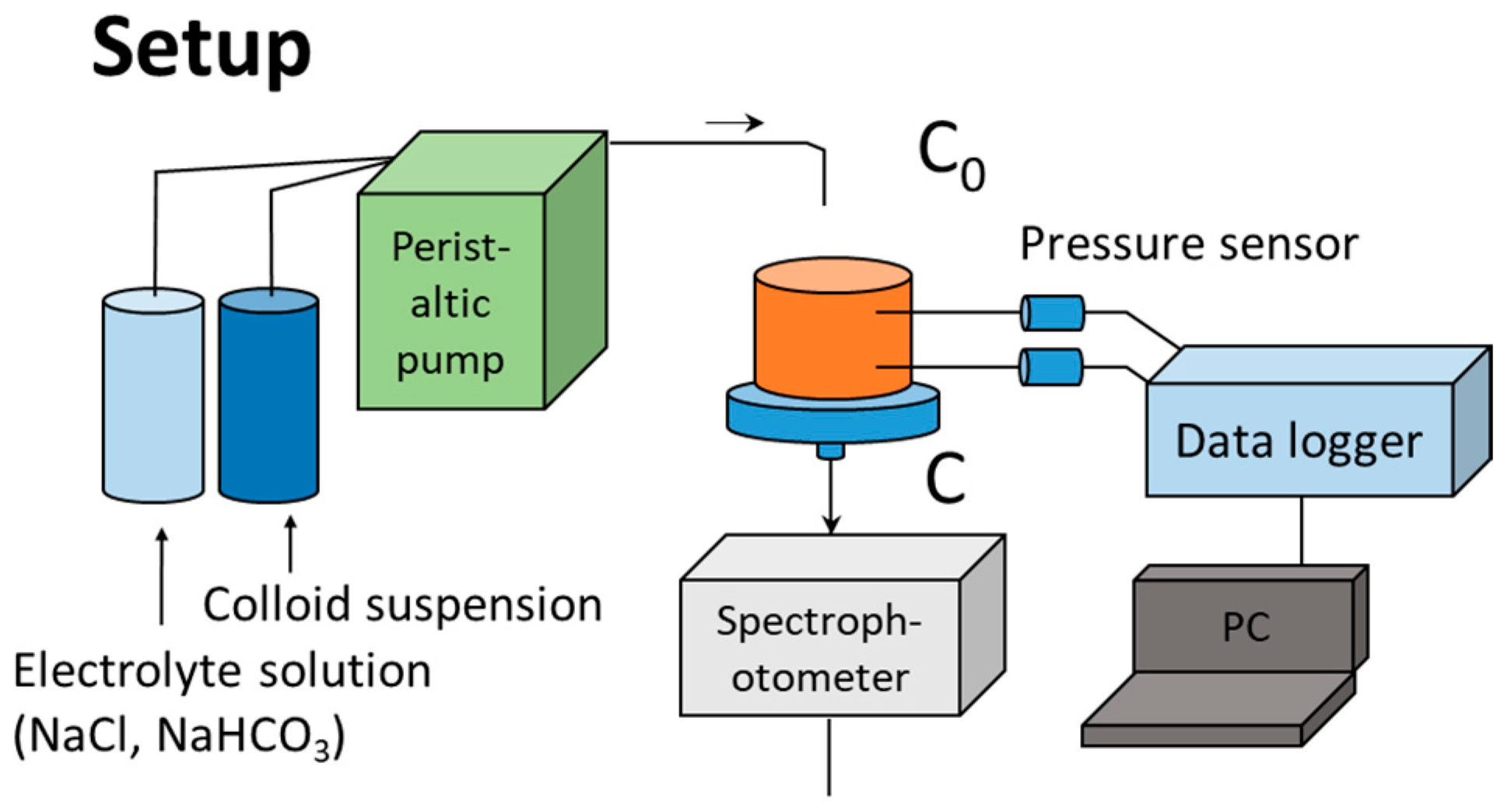
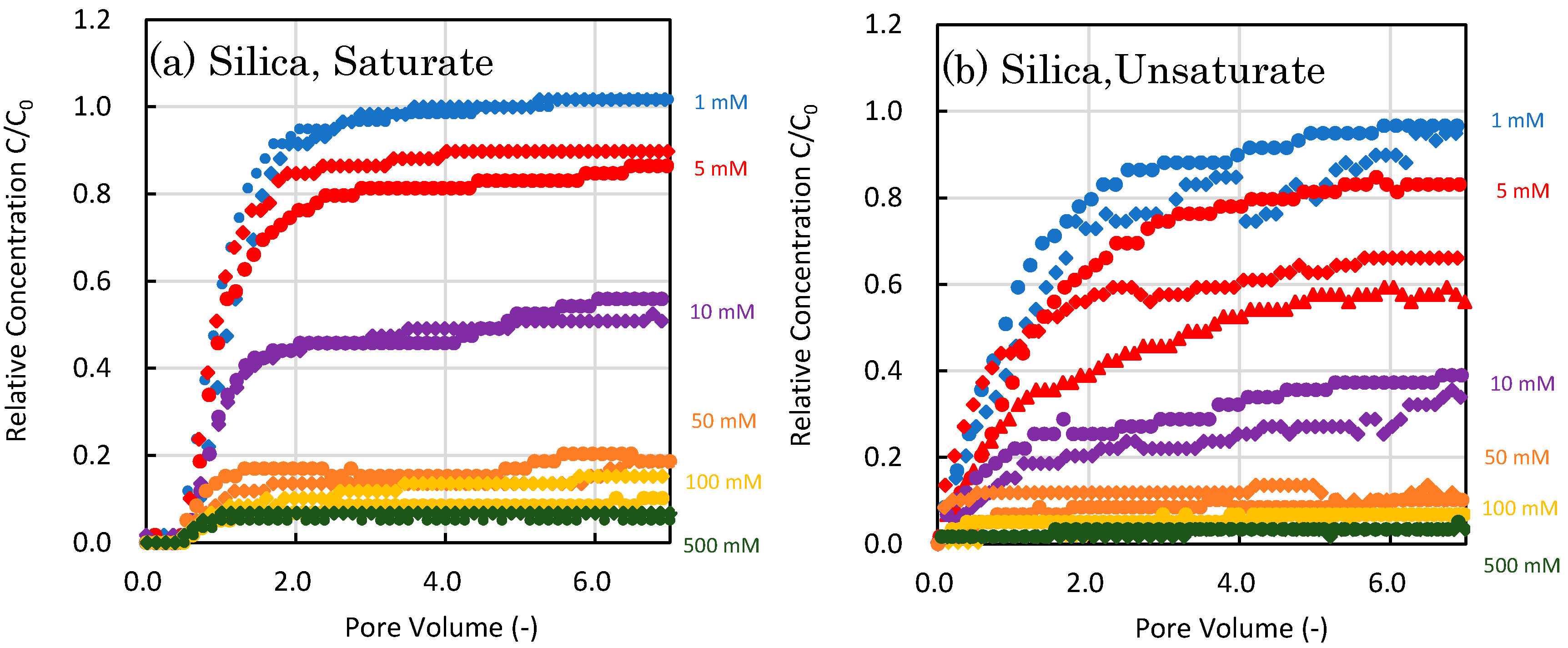
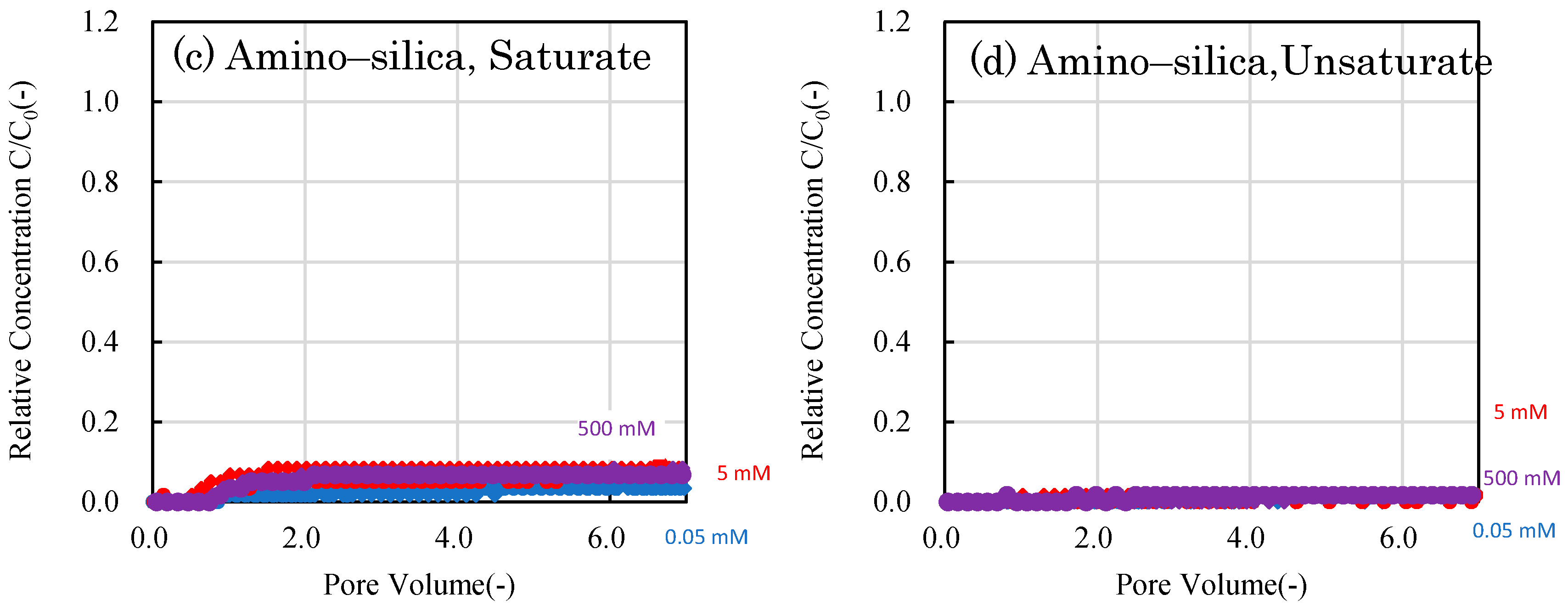
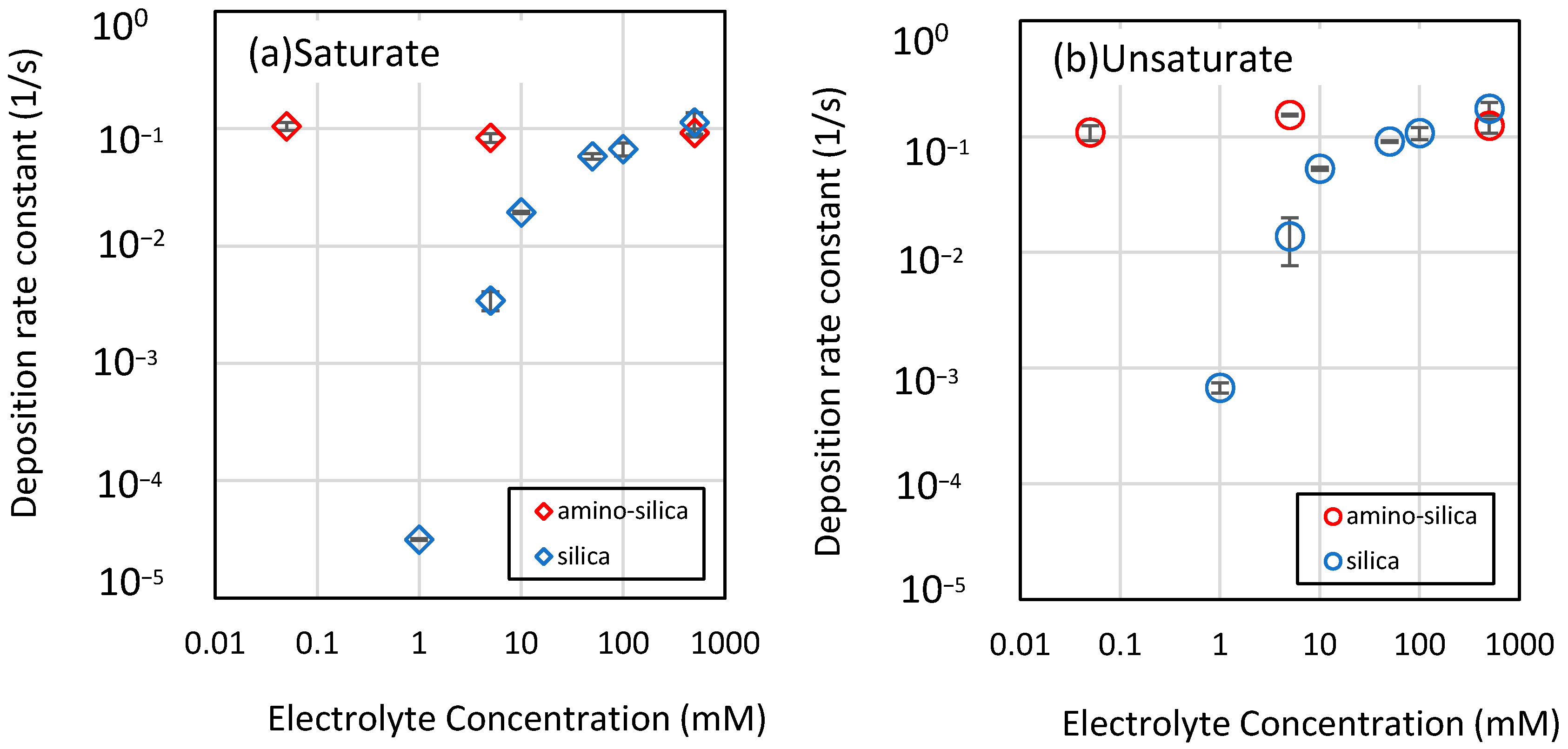
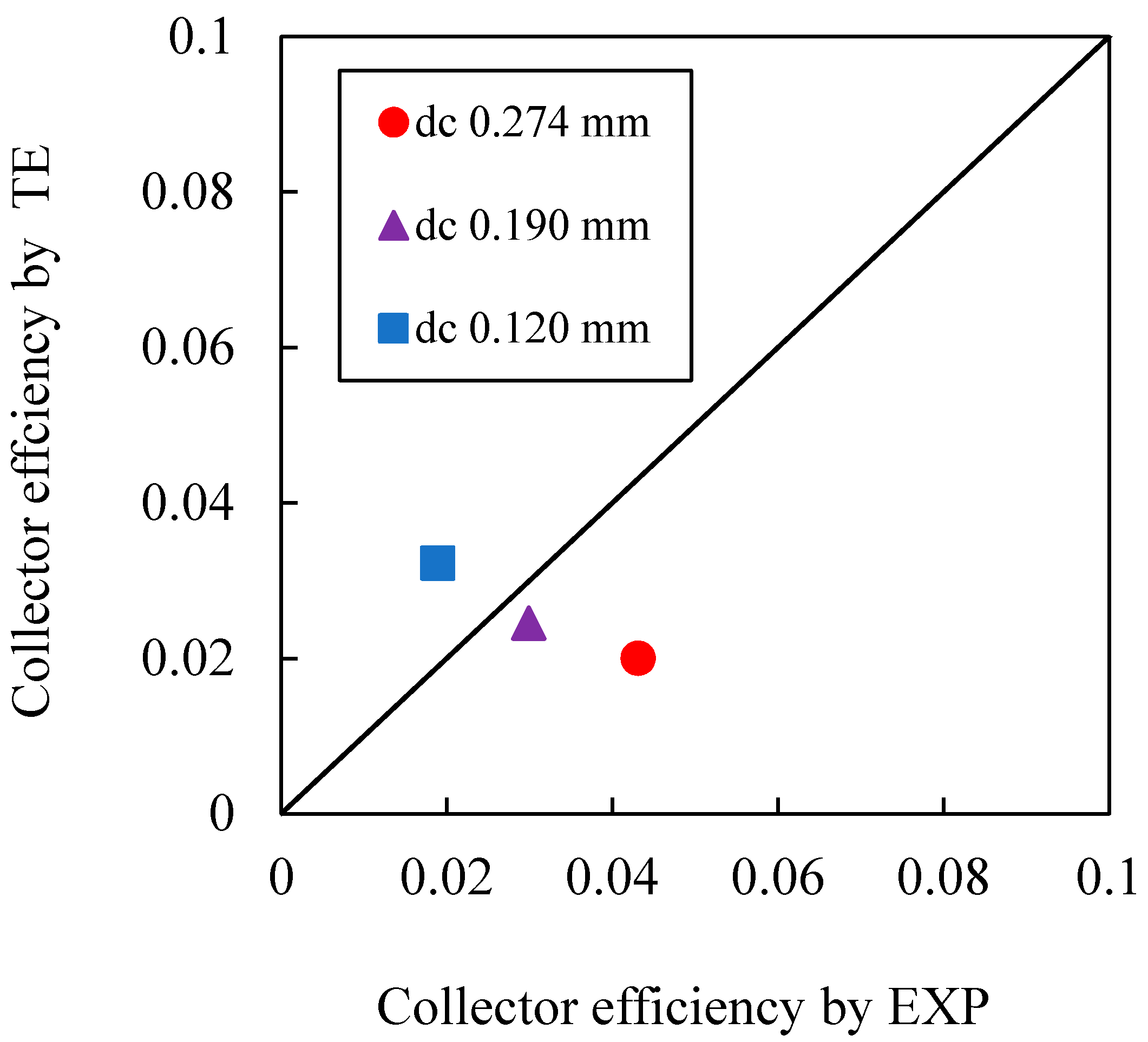
| Condition | pH | Saturation | Approach | Pore Water | |
|---|---|---|---|---|---|
| Particle | Saturation | (%) | Velocity (10−3 cm/s) | Velocity (10−3 cm/s) | |
| Silica | Saturated | 6.9 ± 0.13 | 100 ± 0 | 3.5 ± 0.11 | 8.1 ± 0.27 |
| Unsaturated | 6.9 ± 0.29 | 48.1 ± 6.3 | 1.7 ± 0.06 | 8.5 ± 1.10 | |
| Amino–silica | Saturated | 5.0 ± 0.34 | 100 ± 0 | 3.6 ± 0.13 | 8.4 ± 0.31 |
| Unsaturated | 5.3 ± 0.21 | 54.7 ± 9.0 | 1.8 ± 0.04 | 7.9 ± 1.42 | |
| Parameters | Units | |
|---|---|---|
| Collector diameter (dc) | 0.274 | Mm |
| Particle diameter (dp) | 490 | Nm |
| Particle density (ρp) | 2200 | kg/m3 |
| Fluid density (ρf) | 1000 | kg/m3 |
| Fluid viscosity (µ) | 1.002 × 10−3 | Pa s |
| Temperature (T) | 293 | K |
| Hamaker constant (A) | 8.3 × 10−21 | J |
| Porosity (f) | 0.429 | - |
| Happel model parameter (As) | 38.0 | - |
Publisher’s Note: MDPI stays neutral with regard to jurisdictional claims in published maps and institutional affiliations. |
© 2020 by the authors. Licensee MDPI, Basel, Switzerland. This article is an open access article distributed under the terms and conditions of the Creative Commons Attribution (CC BY) license (http://creativecommons.org/licenses/by/4.0/).
Share and Cite
Fujita, Y.; Kobayashi, M. The Initial Deposition Behavior of Silica Colloid and Amino-Modified Silica Colloid in Unsaturated Sand Columns. Water 2020, 12, 2892. https://doi.org/10.3390/w12102892
Fujita Y, Kobayashi M. The Initial Deposition Behavior of Silica Colloid and Amino-Modified Silica Colloid in Unsaturated Sand Columns. Water. 2020; 12(10):2892. https://doi.org/10.3390/w12102892
Chicago/Turabian StyleFujita, Yosuke, and Motoyoshi Kobayashi. 2020. "The Initial Deposition Behavior of Silica Colloid and Amino-Modified Silica Colloid in Unsaturated Sand Columns" Water 12, no. 10: 2892. https://doi.org/10.3390/w12102892
APA StyleFujita, Y., & Kobayashi, M. (2020). The Initial Deposition Behavior of Silica Colloid and Amino-Modified Silica Colloid in Unsaturated Sand Columns. Water, 12(10), 2892. https://doi.org/10.3390/w12102892




